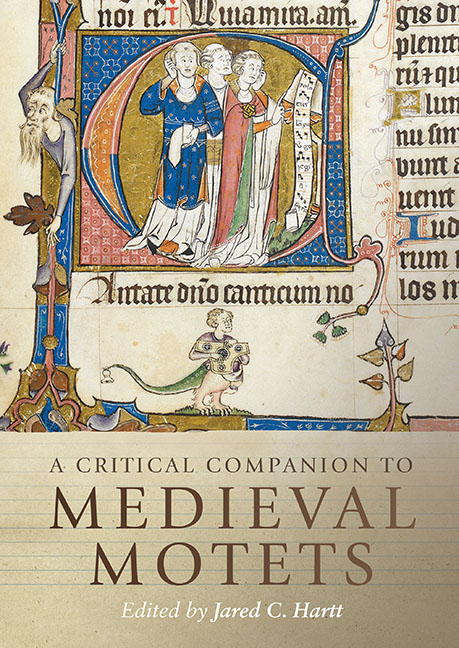Book contents
- Frontmatter
- Dedication
- Contents
- List of Figures
- List of Music Examples
- List of Tables
- List of Contributors
- Preface
- Acknowledgments
- Abbreviations
- Introduction: Approaching Medieval Motets
- 1 The Genre(s) of Medieval Motets
- 2 Origins and Interactions: Clausula, Motet, Conductus
- 3 Tracing the Tenor in Medieval Motets
- 4 Isorhythm
- 5 Notation
- 6 Thirteenth-Century Motet Functions: Views through the Lens of the Portare Motet Family
- 7 A Prism of its Time: Social Functions of the Motet in Fourteenth-Century France
- 8 Motets, Manuscript Culture, Mise-en-page
- 9 Clerics, Courtiers, and the Vernacular Two-Voice Motet: The Case of Fines amouretes / Fiat and the Roman de la poire
- 10 When Words Converge and Meanings Diverge: Counterexamples to Polytextuality in the Thirteenth-Century Mote
- 11 Motets in Chansonniers and the Other Culture of the French Thirteenth-Century Motet
- 12 Building a Motet around Quoted Material: Textual and Musical Structure in Motets Based on Monophonic Songs
- 13 The Duet Motet in England: Genre, Tonal Coherence, Reconstruction
- 14 Materia Matters: Reconstructing Colla/Bona
- 15 Machaut’s Motet 10 and its Interconnections
- 16 A Motet Conceived in Troubled Times: Machaut’s Motet 22
- 17 A Motet Ahead of its Time? The Curious Case of Portio nature/Ida capillorum
- Bibliography of Works Cited
- Select Glossary
- Index of Cited Motets
- General Index
- Studies in Medieval and Renaissance Music
10 - When Words Converge and Meanings Diverge: Counterexamples to Polytextuality in the Thirteenth-Century Mote
Published online by Cambridge University Press: 21 October 2020
- Frontmatter
- Dedication
- Contents
- List of Figures
- List of Music Examples
- List of Tables
- List of Contributors
- Preface
- Acknowledgments
- Abbreviations
- Introduction: Approaching Medieval Motets
- 1 The Genre(s) of Medieval Motets
- 2 Origins and Interactions: Clausula, Motet, Conductus
- 3 Tracing the Tenor in Medieval Motets
- 4 Isorhythm
- 5 Notation
- 6 Thirteenth-Century Motet Functions: Views through the Lens of the Portare Motet Family
- 7 A Prism of its Time: Social Functions of the Motet in Fourteenth-Century France
- 8 Motets, Manuscript Culture, Mise-en-page
- 9 Clerics, Courtiers, and the Vernacular Two-Voice Motet: The Case of Fines amouretes / Fiat and the Roman de la poire
- 10 When Words Converge and Meanings Diverge: Counterexamples to Polytextuality in the Thirteenth-Century Mote
- 11 Motets in Chansonniers and the Other Culture of the French Thirteenth-Century Motet
- 12 Building a Motet around Quoted Material: Textual and Musical Structure in Motets Based on Monophonic Songs
- 13 The Duet Motet in England: Genre, Tonal Coherence, Reconstruction
- 14 Materia Matters: Reconstructing Colla/Bona
- 15 Machaut’s Motet 10 and its Interconnections
- 16 A Motet Conceived in Troubled Times: Machaut’s Motet 22
- 17 A Motet Ahead of its Time? The Curious Case of Portio nature/Ida capillorum
- Bibliography of Works Cited
- Select Glossary
- Index of Cited Motets
- General Index
- Studies in Medieval and Renaissance Music
Summary
A VITAL CHARACTERISTIC of the polyphonic thirteenth-century motet is polytextuality. Even two-voice motets are polytextual insofar as the tenor typically contains a melisma based on a word or two or a fragment of a word from a chant, while the upper voice contains a fully fledged text. In the case of three- and four-voice motets, the more explicit polytextual nature of the genre comes to the fore, as the upper voices each contain different texts, sometimes even in different languages. Within this verbal texture, Christopher Page has argued that an important part of the genre's aesthetic is the design of brief moments of convergence of a vowel sound, rhyme, syllable, or even a word amongst the upper voices. Page suggested that such exceptions to the heterogeneous verbal texture may have been what Johannes de Grocheio had in mind when he remarked on the artistic ‘refinement’ of motets. Using the motet Par un matinet (658) / Hé, sire (659) / Hé, bergier (657) / Eius (O16) as his model, Page observed that such confluence is both fleeting and rare. Hence its refined status. Although perhaps not quite as rare as Page suggested, it is nonetheless the case that in a genre where the emphasis is on the differences amongst the texts, convergences seem privileged and special.
There are, however, some motets where long stretches of monotextuality seem to be the point. Striking because they are exceptions to the general rule, the most celebrated of these are even preserved in succession in the Montpellier codex as Mo 26 and Mo 27: Viderunt. Por peu ne sui departis (7) / Viderunt. Por peu li cuers ne me parti (6) / Viderunt. Par pou le cuer ne me parti (5) / Viderunt om[nes] (M1) and Trois serors sor rive mer … La jonete (343a) / Trois serors sor rive mer … La moiene (343b) / Trois serors sor rive mer … L’aisnee (343c) / Perlustravit (M25). Mo 27 is the clearest example because all three upper voices begin with an identical text sustained for an entire sentence spanning two musical phrases, ‘Trois serors sor rive mer / chantent cler’ (‘Three sisters at the seashore are singing brightly’).
- Type
- Chapter
- Information
- A Critical Companion to Medieval Motets , pp. 205 - 224Publisher: Boydell & BrewerPrint publication year: 2018

